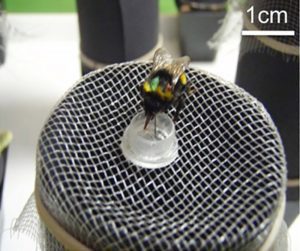

Cucumber mosaic virus is a (+) strand RNA virus that is a pathogen of tomato plants. The virus is spread by aphids, and bumblebees increase fruit yield by buzz-pollination (tomato plants are self-pollinating but bumblebees cause increased seed production).
To study the attraction of bumblebees to tomato plants, the authors encased single tomato plants in a tower topped with a screen and a small cup of 30% sucrose (shown in photo: credit). This arrangement allowed volatile compounds to waft through the screen above the plant.
Bumblebees clearly preferred to visit the CMV-infected over the uninfected plants. They also shunned plants infected with a mutant of CMV that cannot antagonize the RNA interference system of the plant – a major defense against viruses. The results suggest that CMV somehow alters plant produced volatile compounds to attract bumblebee pollinators, and that production of these compounds is regulated by microRNAs.
These findings – that CMV infected plants attract bees via the production of volatiles under the control of microRNAs – were confirmed using Arabidopsis, a model plant which can be genetically manipulated.
Chemical analysis of the volatiles produced by infected and uninfected tomato plants revealed that virus infection reduced the levels of two terpenoids, 2-carene and beta-phellandrene. These compounds are known to repel bumblebees, leading to the suggestion that their reduction may explain why bees prefer infected plants.
Is attraction of bumblebees by viral infection random, or does it have a purpose? CMV infection of tomato plants decreases seed production, an effect that is reversed when bumblebees are attracted to the plants and pollinate them.
The results show that CMV infection of tomato plants causes the emission of volatile compounds that attract pollinating bumblebees, which negate the inhibition of seed production by infection.
Bumblebees do not transmit CMV, so how did this non-fatal attraction come about? One can imagine that at one time CMV infection of plants did not attract bumblebees, and that infection severely depressed plant production. Then a random viral mutant arose that could induce the proper volatiles to attract bumblebees. This change provided a selective advantage because plant seed production was restored by bumblebee pollination. This is called a ‘payback’ hypothesis: the virus has a place to replicate, and the plant lives on due to virus-induced volatile compounds.
I have a bit of trouble with this payback idea, because at the base of it are human-like intentions. Why do we assume that what drives evolution are forces that make sense to us? The plant-centric view is that it was not a CMV mutant, but a plant mutant that arose, which could make the proper bumblebee attractants upon CMV infection. The selective force to maintain such a plant is very clear and involves no anthropocentric ‘payback’.
Whatever the origin of this non-fatal attraction, it merits further study, not only for developing better pollination methods, but for understanding the viral-host symbiosis.

In reducing levels of 2-carene and beta-phellandrene, it sounds like infection makes flowers less repellent rather than more attractive. The distinction matters, I think, because it leads to the question of why a plant that benefits from increased bumblebee visitation would emit volatiles that drive them away.
A similar question was addressed in a course that I took last semester, looking at the toxic or bad-tasting nectar produced by some plants. In those cases, a variety of possible explanations were given: for example, it could be that the compounds that pollinators find so offensive are just an unavoidable side effect of anti-herbivore defence, and/or, and there’s some evidence for this in tobacco, it could be part of a push-pull strategy to reduce nectaring time. The idea is to conserve nectar – pollinators are drawn in by more pleasing odours, then quickly driven away by the bad taste – and, more importantly, encourage the visitation of as many flowers as possible to promote out-crossing.
All that being said, I don’t have an alternative explanation for what they observed, but I am also uncomfortable with the payback hypothesis. I just have the feeling that there’s probably more going on: the observed benefit from increased buzz pollination could well be driving the evolution of either virus or plant, but it could also be a side effect of whatever’s really driving virus or plant evolution. Either way, it’s a fascinating topic, and I hope people will keep working on it!
Does the virus spread through tomato seeds?
The plant-centric view seems the most efficient strategy for the plant but what if the viral mutant just happened to turn up first?
Maybe the the viral mechanism to increase seed production requires less mutations than that required for the plant to set up a counter-mechanism when infected.
A plant with increased seed production when infected may have diminished seed production without an infection.
CMV is often seedborne, so it can spread without insects – but is also often efficiently transmitted by aphids. Which I notice are not mentioned in the article….